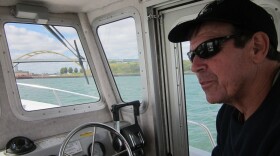Yellow perch are a staple of firehouse and church fish fries, and the delicate fish on that dish might once have lived in the Great Lakes. But warmer lake waters in a changing climate threaten the yellow perch population as well as other popular cool water fish, like walleye.
Searching for perch
It feels like we’re in the middle of nowhere on Lake Erie. Two young women are straining to drag a fishing net onto the deck of their research boat. Finally, they pull the last bit in.
"Oh yeah!” they yell.
A few dozen fish are dumped from the net into a bucket. Among them is a little guy with dark stripes.
U.S. Geological Survey biologist Richard Kraus is positively tickled about finding a little yellow perch.
“Young of the year perch. Oh my goodness… So that’s a young of the year yellow perch.”
It's exciting because some research has been showing that white perch might be crowding it out. The yellow perch are important to the fishery economics of the entire Great Lakes--especially Erie.
What happens in Lake Erie does not stay in Lake Erie
Because it’s the shallowest and southernmost of the Great Lakes, it can signal what will happen throughout the lakes. But Kraus says conditions have favored the white perch.
“Since about the '60s, we’ve had a gradual increase in temperature in the lake. That correlates really well with white perch population abundance.”
White perch are native to the Atlantic and considered invasive in the Great Lakes. Kraus says that while some people do fish for and eat them here, when they’re living in freshwater, they just aren’t very tasty. But if the warming trend continues in Lake Erie, Kraus says,“It could be fantastic for white perch.”
The interaction between white and yellow perch is what one Ohio State University researcher has been studying for a few decades.
Stu Ludsin has been playing out different scenarios in his lab in Columbus.
When he replicated warm short winters for yellow perch:
“Egg quality was very low. Eggs were smaller in size and they had fewer lipids, fewer calories per egg. And then in addition, hatching success of these eggs was lower,” he says.
On top of that, perch larvae were smaller and more vulnerable to predators. And as temperatures continue warming, it’s not just yellow perch that might suffer. Ludsin says walleye might have a hard time, too.
"I always expect yellow perch and species like walleye to be dominant players in Lake Erie. But the way conditions in the lake are going, in terms of especially the winter warming piece, it's not moving in a direction that's favoring these species."
“You know, I always expect yellow perch and species like walleye to be dominant players in Lake Erie. But the way conditions in the lake are going, in terms of especially the winter warming piece, it’s not moving in a direction that’s favoring these species,” he says.
A conundrum
Fisheries managers are just beginning to deal with these kinds of interactions between invasive species and climate change.
It’s something Stas Burgiel’s working on at the National Invasive Species Council in Washington, DC. It’s a program of federal government agencies.
He’s leading a task force of representatives from around the U.S. He says that so far, most work on invasives and climate change has focused on exotic species on land.
“We just have a longer history of dealing with invasive plants and forest pests. On the aquatic side, just in terms of managing invasive species, it’s very difficult because water bodies are connected, they’re flowing,” he says.
Still, Burgiel says he remains hopeful that management will catch up to the research. That would be good news for the multi-billion dollar Great Lakes fishing industry, and our fish dinners.






